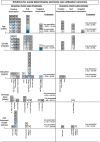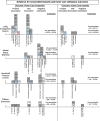Social factors influencing utilization of home care in community-dwelling older adults: a scoping review
- PMID: 33639856
- PMCID: PMC7912889
- DOI: 10.1186/s12877-021-02069-1
Social factors influencing utilization of home care in community-dwelling older adults: a scoping review
Abstract
Background: Older adults want to live at home as long as possible, even in the face of circumstances that limit their autonomy. Home care services reflect this emergent preference, allowing older adults to 'age in place' in familiar settings rather than receiving care for chronic health conditions or ageing needs in an institutionalized setting. Numerous social factors, generally studied in isolation, have been associated with home care utilization. Even so, social circumstances are complex and how these factors collectively influence home care use patterns remains unclear.
Objectives: To provide a broad and comprehensive overview of the social factors influencing home care utilization; and to evaluate the influence of discrete social factors on patterns of home care utilization in community-dwelling older adults in high-income countries.
Methods: A scoping review was conducted of six electronic databases for records published between 2010 and 2020; additional records were obtained from hand searching review articles, reference lists of included studies and documents from international organisations. A narrative synthesis was presented, complemented by vote counting per social factor, harvest plots and an evaluation of aggregated findings to determine consistency across studies.
Results: A total of 2,365 records were identified, of which 66 met inclusion criteria. There were 35 discrete social factors grouped into four levels of influence using a socio-ecological model (individual, relationship, community and societal levels) and grouped according to outcome of interest (home care propensity and intensity). Across all studies, social factors consistently showing any association (positive, negative, or equivocal in pattern) with home care propensity were: age, ethnicity/race, self-assessed health, insurance, housing ownership, housing problems, marital status, household income, children, informal caregiving, social networks and urban/rural area. Age, education, personal finances, living arrangements and housing ownership were associated with home care intensity, also with variable patterns in utilization. Additional community and societal level factors were identified as relevant but lacking consistency across the literature; these included rurality, availability of community services, methods of financing home care systems, and cultural determinants.
Conclusion: This is the first literature review bringing together a wide range of reported social factors that influence home care utilization. It confirms social factors do influence home care utilization in complex interactions, distinguishes level of influences at which these factors affect patterns of use and discusses policy implications for home care reform.
Keywords: Community care; Formal care; Health care utilization; Home health care; Influencing aspects; Social support; Social vulnerability.
Conflict of interest statement
KR is President and Chief Science Officer of DGI Clinical, which in the last five years has contracts with pharma and device manufacturers on individualized outcome measurement. In 2017 he attended an advisory board meeting with Lundbeck. Otherwise any personal fees are for invited guest lectures and academic symposia, received directly from event organizers, chiefly for presentations on frailty. He is Associate Director of the Canadian Consortium on Neurodegeneration in Aging, which is funded by the Canadian Institutes of Health Research, and with additional funding from the Alzheimer Society of Canada and several other charities, as well as, in its first phase (2013–2018), from Pfizer Canada and Sanofi Canada. He receives career support from the Dalhousie Medical Research Foundation as the Kathryn Allen Weldon Professor of Alzheimer Research, and research support from the Canadian Institutes of Health Research, the QEII Health Science Centre Foundation, the Capital Health Research Fund and the Fountain Family Innovation Fund of the QEII Health Science Centre Foundation. MKA reports grant funding and honoraria from Sanofi, GSK, Pfizer and the Canadian Frailty Network for work relating to frailty and vaccine preventable illness. All other authors declare that they have no competing interests.
Figures





Similar articles
-
Beyond the black stump: rapid reviews of health research issues affecting regional, rural and remote Australia.Med J Aust. 2020 Dec;213 Suppl 11:S3-S32.e1. doi: 10.5694/mja2.50881. Med J Aust. 2020. PMID: 33314144
-
Older Adults' Social Relationships and Health Care Utilization: A Systematic Review.Am J Public Health. 2018 Apr;108(4):e1-e10. doi: 10.2105/AJPH.2017.304256. Epub 2018 Feb 22. Am J Public Health. 2018. PMID: 29470115 Free PMC article.
-
Social isolation in community-dwelling seniors: an evidence-based analysis.Ont Health Technol Assess Ser. 2008;8(5):1-49. Epub 2008 Oct 1. Ont Health Technol Assess Ser. 2008. PMID: 23074510 Free PMC article.
-
Recovery schools for improving behavioral and academic outcomes among students in recovery from substance use disorders: a systematic review.Campbell Syst Rev. 2018 Oct 4;14(1):1-86. doi: 10.4073/csr.2018.9. eCollection 2018. Campbell Syst Rev. 2018. PMID: 37131375 Free PMC article.
-
The impact of transitional care programs on health services utilization in community-dwelling older adults: a systematic review.JBI Database System Rev Implement Rep. 2018 Feb;16(2):345-384. doi: 10.11124/JBISRIR-2017-003486. JBI Database System Rev Implement Rep. 2018. PMID: 29419621
Cited by
-
Geri Models of Care (MOC): An Immersive Preclerkship Curriculum Fostering Student Exploration of Residential Geriatric Models of Care.MedEdPORTAL. 2022 Jul 19;18:11262. doi: 10.15766/mep_2374-8265.11262. eCollection 2022. MedEdPORTAL. 2022. PMID: 35949888 Free PMC article.
-
Impact of community care services on the health of older adults: evidence from China.Front Public Health. 2023 Apr 18;11:1160151. doi: 10.3389/fpubh.2023.1160151. eCollection 2023. Front Public Health. 2023. PMID: 37143978 Free PMC article.
-
Aging in Place and Healthcare Equity: Using Community Partnerships to Influence Health Outcomes.Healthcare (Basel). 2025 May 13;13(10):1132. doi: 10.3390/healthcare13101132. Healthcare (Basel). 2025. PMID: 40427968 Free PMC article.
-
Frailty and diabetes: A study in patients with proliferative diabetic retinopathy.J Int Med Res. 2025 Jun;53(6):3000605251347414. doi: 10.1177/03000605251347414. Epub 2025 Jun 10. J Int Med Res. 2025. PMID: 40492483 Free PMC article.
-
Demand analysis of health care services for community-dwelling breast cancer survivors based on the Kano model: A cross-sectional study.Int J Nurs Sci. 2024 Mar 16;11(2):171-178. doi: 10.1016/j.ijnss.2024.03.015. eCollection 2024 Apr. Int J Nurs Sci. 2024. PMID: 38707692 Free PMC article.
References
-
- Laporte A, Croxford R, Coyte PC. Can a publicly funded home care system successfully allocate service based on perceived need rather than socioeconomic status? A Canadian experience: publicly funded home care. Health Soc Care Community. 2006;15(2):108–119. doi: 10.1111/j.1365-2524.2006.00672.x. - DOI - PubMed
-
- World Health Organization . World report on ageing and health. Geneva: World Health Organization; 2015.
-
- World Health Organization . Global strategy and action plan on ageing and health. Geneva: World Health Organization; 2017.
-
- Government of Canada. Home and community health care [Internet]. 2016 [cited 2020 Jun 28]. Available from: https://www.canada.ca/en/health-canada/services/home-continuing-care/hom...
Publication types
MeSH terms
LinkOut - more resources
Full Text Sources
Other Literature Sources
Medical
Miscellaneous

